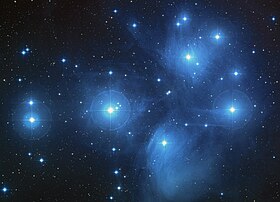Merope (star)
| Observation data Epoch J2000 Equinox J2000 | |
|---|---|
| Constellation | Taurus |
| Right ascension | 03h 46m 19.57384s[1] |
| Declination | 23° 56′ 54.0812″[1] |
| Apparent magnitude (V) | 4.18[2] |
| Characteristics | |
| Spectral type | B6IV(e)[3] |
| U−B color index | -0.41[4] |
| B−V color index | -0.06[4] |
| Variable type | β Cephei[5] |
| Astrometry | |
| Radial velocity (Rv) | 6.2[6] km/s |
| Proper motion (μ) | RA: 21.13[1] mas/yr Dec.: -43.65[1] mas/yr |
| Parallax (π) | 8.58 ± 0.37 mas[1] |
| Distance | 380 ± 20 ly (117 ± 5 pc) |
| Details | |
| Radius | 5.1[7] R☉ |
| Surface gravity (log g) | 4.0[7] cgs |
| Temperature | 13,360 ± 340[7] K |
| Other designations | |
| Database references | |
| SIMBAD | data |
Merope /ˈmɛrəpiː/,[8] designated 23 Tauri (abbreviated 23 Tau), is a star in the constellation of Taurus and a member of the Pleiades star cluster. It is approximately 380 light years away.
Description
Merope is a blue-white B-type subgiant with a mean apparent magnitude of +4.14. Richard Hinckley Allen described the star as lucid white and violet.[9] It has a luminosity of 630 times that of the Sun and a surface temperature of 14,000 kelvins. Merope's mass is roughly 4.5 solar masses and has a radius more than 4 times as great as the Sun's. It is classified as a Beta Cephei type variable star and its brightness varies by 0.01 magnitudes.[5]
Surrounding Merope is the Merope Nebula (NGC 1435). It appears brightest around Merope and is listed in the Index Catalogue as number IC 349.
Nomenclature
23 Tauri is the star's Flamsteed designation. The name Merope originates with Greek mythology; she is one of the seven daughters of Atlas and Pleione known as the Pleiades. In 2016, the International Astronomical Union organized a Working Group on Star Names (WGSN)[10] to catalog and standardize proper names for stars. The WGSN's first bulletin of July 2016[11] included a table of the first two batches of names approved by the WGSN; which included Merope for this star. It is now so entered in the IAU Catalog of Star Names.[12]
References
- ^ a b c d e Van Leeuwen, F (2007). "Validation of the new Hipparcos reduction". Astronomy and Astrophysics. 474 (2): 653–664. arXiv:0708.1752. Bibcode:2007A&A...474..653V. doi:10.1051/0004-6361:20078357. S2CID 18759600.
- ^ Ducati, J. R (2002). "VizieR Online Data Catalog: Catalogue of Stellar Photometry in Johnson's 11-color system". CDS/ADC Collection of Electronic Catalogues. 2237. Bibcode:2002yCat.2237....0D.
- ^ Slettebak, A (1982). "Spectral types and rotational velocities of the brighter Be stars and A-F type shell stars". Astrophysical Journal Supplement Series. 50: 55. Bibcode:1982ApJS...50...55S. doi:10.1086/190820.
- ^ a b Crawford, D. L.; Barnes, J. V.; Golson, J. C. (1971), "Four-color, Hbeta, and UBV photometry for bright B-type stars in the northern hemisphere", The Astronomical Journal, 76: 1058, Bibcode:1971AJ.....76.1058C, doi:10.1086/111220
- ^ a b Samus, N. N.; Durlevich, O. V.; et al. (2009). "VizieR Online Data Catalog: General Catalogue of Variable Stars (Samus+ 2007-2013)". VizieR On-line Data Catalog: B/GCVS. Originally Published in: 2009yCat....102025S. 1. Bibcode:2009yCat....102025S.
- ^ Wilson, Ralph Elmer (1953). "General catalogue of stellar radial velocities". Washington. Bibcode:1953GCRV..C......0W.
- ^ a b c Underhill, A. B.; et al. (November 1979), "Effective temperatures, angular diameters, distances and linear radii for 160 O and B stars", Monthly Notices of the Royal Astronomical Society, 189 (3): 601–605, Bibcode:1979MNRAS.189..601U, doi:10.1093/mnras/189.3.601
- ^ Davis, George A. (1944). "The pronunciations, derivations, and meanings of a selected list of star names". Popular Astronomy. 52: 8–30. Bibcode:1944PA.....52....8D.
- ^ Merope, Star Names and their Meanings, Richard Hinckley Allen, Dover Publications, 1963, p. 407.
- ^ "IAU Working Group on Star Names (WGSN)". Retrieved 22 May 2016.
- ^ "Bulletin of the IAU Working Group on Star Names, No. 1" (PDF). Retrieved 28 July 2016.
- ^ "IAU Catalog of Star Names". Retrieved 28 July 2016.
External links
- Jim Kaler's Stars, University of Illinois:Merope (23 Tauri)
- NGC 1435 - Merope Nebula LRGB image with 4 hours total exposure.

